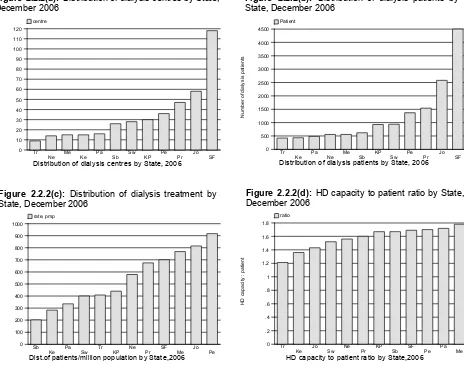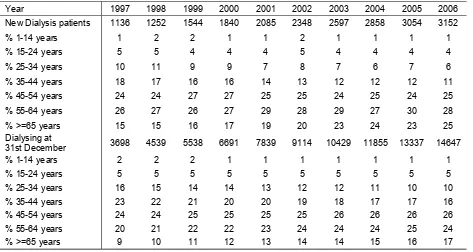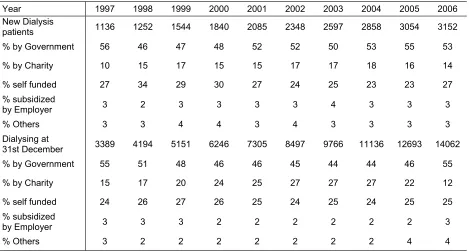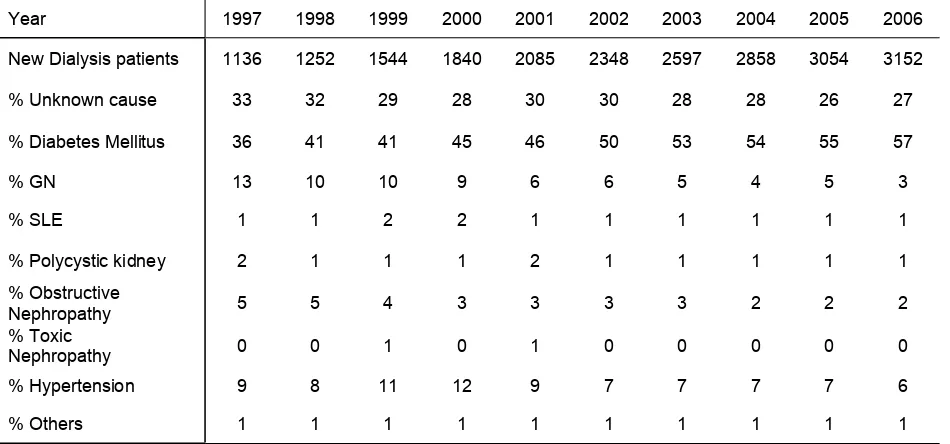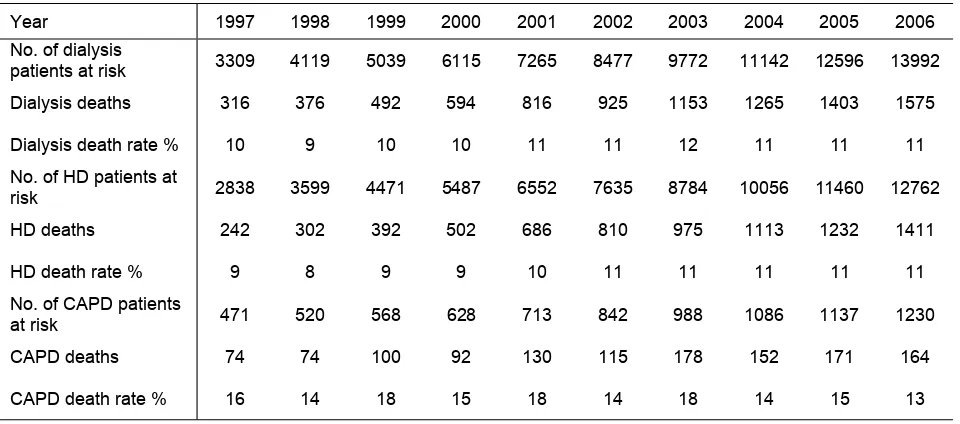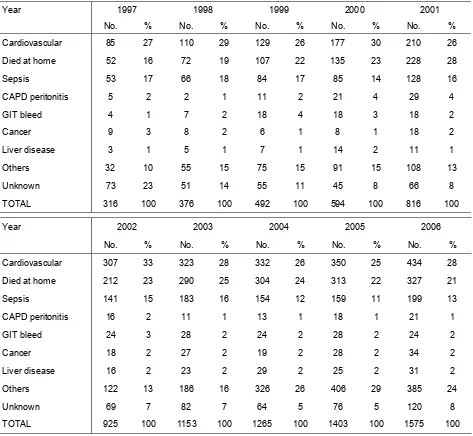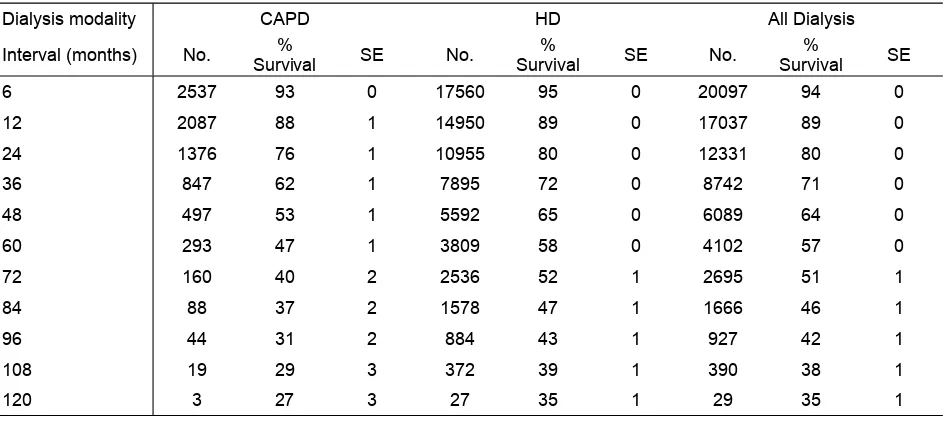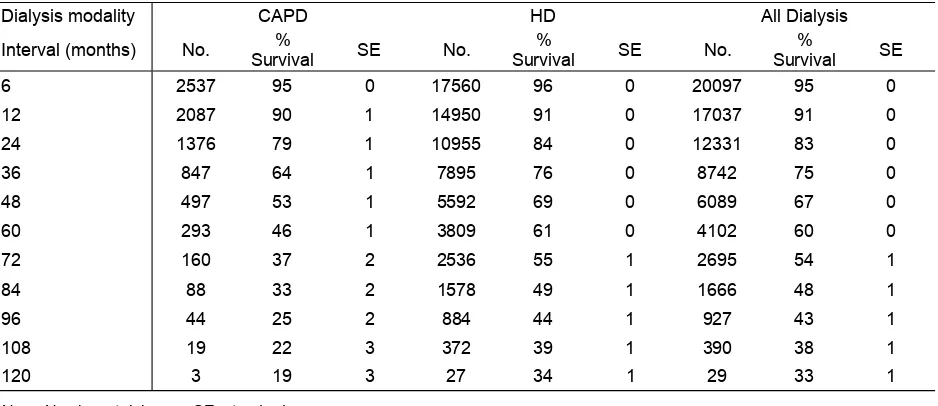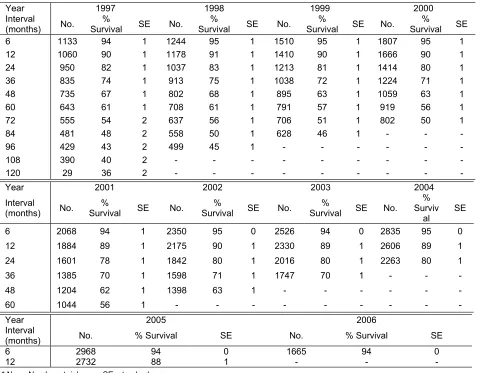Sponsors:
Malaysian Society of Nephrology
Association of Dialysis Medical Assistants and Nurses
The National Renal Registry is funded with grants from:
The Ministry of Health Malaysia
Ain Medicare
Baxter Healthcare
Fresenius Medical Care
Roche
14
th
Report
of
The Malaysian
Dialysis & Transplant Registry
April 2007
© Nattional Renal Registry, Malaysia
ISSN 1675-8862
Published by:
The National Renal Registry
Malaysian Society of Nephrology
2
ndFloor, MMA House
124, Jalan Pahang
50286 Kuala Lumpur
Malaysia
Telephone
: (603) 4045 8636
Direct Fax
: (603) 4042 7694
e-mail :
nrr@msn.org.my
Web site
:
http://www.msn.org.my/nrr
Important information:
This report is copyrighted. However it may be freely
reproduced without the permission of the National
Renal Registry. Acknowledgment would be
appreciated. Suggested citation is: YN Lim, TO Lim
(Eds). Fourteenth Report of the Malaysian Dialysis and
Transplant Registry 2006. Kuala Lumpur 2007
This report is also published electronically on the
website of the National Renal Registry at:
ACKNOWLEDGEMENTS
The National Renal Registry would like to thank the following:
All the nephrologists and staff of the dialysis and transplant follow-up centres
for their hard work and participation,
The Ministry of Health, Malaysia for support seen and unseen
Our industry sponsors
Ain Medicare
Baxter Healthcare
Fresenius Medical Care
Roche
The staff of the Clinical Research Centre for IT and statistical support
The National Transplant Registry
&
NRR Advisory Committee Members
2006 to 2008
Malaysian Society of Nephrology Nominees
Chairperson
Dr. Rozina Ghazalli
Co-Chairman
Dr. Zaki Morad b Mohd Zaher
Member
Dr. Lim Teck Onn
Dr. Lim Yam Ngo
Dr. T. Thiruventhiran
Dr. Tan Hee Wu
Dr. Wong Hin Seng
Association of Dialysis Medical Assistants & Nurses
Nominee
Members
Tam Chong Chiang
Norlida Omar
NRR Office Staff
Registry Manager
Lee Day Guat
Registry Assistant
Suhazelini Ali
Mardhiah
Arifin
Nor Azliana Ramli
CRC Technical Support Staff
Director
Dr. Lim Teck Onn
Epidemiologist
Dr. Jamaiyah Haniff
Head of ICT Unit
Celine Tsai Pao Chien
Database Administrator Lim Jie Ying
Sebastian
Thoo
Network Administrator
Kevin Ng Hong Heng
Adlan Ab Rahman
Scott
Huang
Statistician
Chen Won Sun Sharon
Tan
Wei
Hao
The National Renal Registry (NRR) has its origin in
the Dialysis and Transplant Registry established by
the Department of Nephrology in 1992. The
sponsors of NRR are the Malaysian Society of
Nephrology (MSN) and Association of Dialysis
Medical Assistants and Nurses (ADMAN)
The objectives of NRR are to:
1. Determine the disease burden attributable
toEnd Stage Renal Disease (ESRD), and its
geographic and temporal trends in Malaysia.
2. Determine the outcomes, and factors
influencing outcomes of Renal
Replacement
Therapy.
3. Evaluate the RRT program.
4. Stimulate and facilitate research on
RRT and ESRD.
5. Maintain the national renal transplant
waiting
list.
The NRR organization is as follows:
Sponsors
The Malaysian Society of Nephrology is the
sponsor of the National Renal Registry (NRR) and
Malaysian Organ Sharing System (MOSS) and the
co-sponsor is the Association of Dialysis Medical
Assistants and Nurses.
Advisory Committee
This is the committee established by the sponsors
to oversee the operations of the registry and MOSS.
Interested parties including source data producers,
Renal Registry Unit and target groups or users are
represented on this committee.
National Renal Registry Office
The NRR office is the coordinating center that
collects and analyses the data. It publishes the
annual report of Malaysian Dialysis & Transplant
Registry and the Directory of Dialysis Centres in
Malaysia. The Clinical Registry Manager (CRM)
oversees the daily operation of the NRR. The
Clinical Research Centre of Hospital Kuala Lumpur
provides the epidemiological, statistical and
information technological support to NRR.
Source Data Producers
These are the dialysis centres that collect the
required data. It is the most critical and yet difficult
element of the system. It has to be systematic and
uniform, and producers of source data need to be
trained and motivated to ensure high data quality.
Users or Target groups
These are the individuals or institutions to whom
the regular registry reports are addressed. It is their
need for information to assist in the planning and
implementing disease treatment, control and
prevention activity that justify the investment in the
registry. They include:
1. the rnal community
2. the RRT provider
3. the public health practitioner
4. the decision maker in various government and
non-government agencies who have
responsibilities for any aspects of ESRD
treatment, prevention and control
5. the researcher with an interest in ESRD and
RRT.
6. the press and the public.
About the National Renal Registry
Malaysian Organ Sharing System or MOSS has been
upgraded to web application named e-MOSS. It was
officially launched by Y. B. Dato Dr. Hj. Abd Latiff
B Ahmad, the Deputy Minister of Health, Malaysia
on 1
stSeptember 2006.
It is managed by the MOSS committee established
under the Malaysian Society of Nephrology (MSN),
with National Renal Registry (NRR) assisting in its
daily operations.
The functions of the MOSS committee are:
1. Make policy decisions concerning MOSS.
2. Secure funding from various sources to support
its
operation.
3. Designate a place to be the coordinating centre.
4. Canvass the views of nephrologists and other
clinical staff involved concerning its policies and
operations.
5. Appoint panel of nephrologists to assist in the
potential
recipient
management.
The objectives of e-MOSS
1. To maintain a list of patients who have
voluntarily enrolled as potential recipients in
the cadaveric kidney transplantation program
in
Malaysia.
2. To prioritise the waiting list according to an
agreed criteria and its scoring system.
3. To update the waiting lists according to the
specified
criteria.
4. To provide a list of suitably matched potential
recipients when a cadaver organ is available.
5. To facilitate centres to effectively manage the
patients’ listing.
The role of e-MOSS:
All patients registered with NRR will be included in
the e-MOSS. However, the subsequent
management of the patients’ lists depends on the
participating centres.
1. The doctor caring for dialysis patients who are
potential recipients can now efficiently maintain
their patients on the lists and update their
patients’ treatment information regularly.
vi
2. The transplant coordinating centres can now
access the potential recipients’ listing that is
ranked according to the pre-determined criteria.
The patient could be easily contactable in the
event of organ donation.
Participation in e-MOSS:
This system is located in a secured site;
https://www.macr.org.my/emoss. There are link
provided from http://msn.org.my or
http://msn.org.my/nrr. All dialysis centres are
welcome to be an e-MOSS user.
How to register with e-MOSS?
1. The dialysis centre needs to register as an
e-MOSS user. Registration instruction and its
documents are available in this web application.
2. Registered centre can nominate more users.
However, the authorization must be from the
centre’s doctor in-charge.
3. All e-MOSS users need to complete a user
agreement form and submit it to NRR
for
processing.
Management of e-MOSS:
All patients registered with NRR shall be listed in the
e-MOSS on the following day according to the
criteria set in the e-MOSS. These are the listing
where patients will be grouped:
1. SOS List
2. On Wait List
3. Auto Off List (Pending data update)
4. Temporary Off List
5. Pending Evaluation
6. Ineligible for transplant
7. Death and Transplanted
1. SOS List:
Patients on this list are given specially priority as
they as expected to have lifespan of less than a year
unless renal transplantations are performed. Only
nephrologists can request placement of patients into
this list and patient will only be placed into this list
after approval is obtained from the MOSS
Committee.
2. On Wait List
Patients listed here are patients who have met the
criteria. These are the potential cadaver organ
recipients.
3. Auto Off List (Pending data update)
If the viral serology results of a patient who is in the
‘On Wait List’ are not updated after 6 months, the
system will automatically placed the patient into
this list. The patient in this list will not be eligible for
organ transplantation.
The patient will be placed back into the “On wait
list” once the serology results have been updated
and the patient will not be penalized.
4. Temporary Off List
Doctor in charge should place the patient who is
temporarily unfit for a transplant into this list so that
he/she will not be contacted in the event of organ
donation.
5. Pending Evaluation
The potential eligible patients will be listed in the
‘Pending List’ upon register\ration with NRR. These
patients’ e-MOSS criteria have not been assessed by
centre’s doctor.
6. Ineligible for transplant
System auto list those patients who do not meet
e-MOSS criteria.
7. Death and Transplanted
PARTICIPATING HAEMODIALYSIS CENTRES
JOHOR
1.
Amitabha Haemodialysis Centre Johor Bahru
2. Batu Pahat Hospital
3. Batu Pahat Rotary
10. Haemodialysis Mawar Gemas
11. Hospital Pakar Sultanah Fatimah Muar
12. JB Lions MAA-Medicare Charity Dialysis Centre (1)
13. JB Lions MAA-Medicare Charity Dialysis Centre (2)
14. JJ Lions Dialysis Centre
15. Johor Specialist Hospital
16. Kluang Hospital
17. Kota Tinggi Hospital
18. Mersing Hospital
19. Muar Dialysis
20. Muar Lions Renal Centre
21. Persatuan Membaiki Akhlak-Che Luan Khor_NKF
22. Pertubuhan Hemodialisis Muhibbah (Labis)
23. Pertubuhan Hemodialisis Muhibbah (Segamat)
24. Pontian Hospital
25. Pontian Rotary Haemodialysis Centre
26. Premier Renal Care
27. Prima Dialysis Kluang
28. Pusat Dialisis & Kesihatan Masjid Bandar Baru Uda
29. Pusat Dialisis Nefro Utama (Kota Tinggi)
30. Pusat Dialisis Nefro Utama (Pontian)
31. Pusat Dialisis Perbadanan Islam (Pontian)
32. Pusat Dialisis Waqaf An-nur (Batu Pahat)
33. Pusat Dialisis Waqaf An-nur (Kota Raya)
34. Pusat Hemodialisis Darul Takzim
35. Pusat Hemodialisis Hidayah
36. Pusat Hemodialisis Rotary Kota Tinggi
37. Pusat Hemodialisis Rotary Kulai
38. Pusat Rawatan Perbadanan Islam (Kota Tinggi)
39. Puteri Specialist Hospital
40. Segamat Hospital
41. Sultan Ismail Hospital
42. Sultanah Aminah Hospital (Paed)
43. Sultanah Aminah Hospital
44. Systemic Dialysis Centre (1)
45. Systemic Dialysis Centre (2)
46. Tangkak Hospital
47. Temenggong Seri Maharaja Tun Ibrahim Hospital
48. The Rotary HD Centre (Johor Bahru)
49. Yayasan Pembangunan Keluarga Johor-NKF
50. Yayasan Rotary Kluang
51. Zhi En Dialysis Centre
KEDAH
52. 807 Rumah Sakit Angkatan Tentera (Sg. Petani)
53. Baling Hospital
54. Buddhist Tzu Chi (Jitra)
55. Kuala Nerang Hospital
56. Kulim Haemodialysis (CS Tan)
57. Kulim Hospital
58. Langkawi Hospital
59. Metro Specialist Hospital
60. Pertubuhan Bakti Fo En Bandar Kulim
61. Pusat Dialisis K K Tan (Kulim)
62. Pusat Dialysis K K Tan (Sg Petani)
63. Pusat Haemodialisis Dr. Ismail
64. Pusat Hemodialisis Beng Siew
65. Pusat Hemodialisis Mergong
66. Pusat Hemodialisis Seroja
67. Pusat Kesihatan Jitra
68. Pusat Rawatan Hemodialisis Yayasan Emkay &
Sultanah
Bahiyah
69. Putra Medical Centre
70. Rawatan Dialisis Amal Lion_NKF
71. Renal Care (Kedah)
72. Renal Medicare
73. Sik Hospital
74. Strand Specialist Hospital
75. Sultan Abdul Halim Hospital
76. Sultanah Bahiyah Hospital
77. Superkids Trinity-NKF Dialysis Centre
78. Yan Hospital
KELANTAN
79. Gua Musang Hospital
80. KB Rotary-MAA Charity Dialysis
81. Kuala Krai Hospital
82. Machang Hospital
83. Nephrolife Haemodialysis Centre
84. Pakar Perdana Hospital
85. Pasir Mas Hospital
86. Pusat Dialisis Yayasan Buah Pinggang
Kebangsaan
(Kota
Bharu)
87. Pusat Perubatan Tentera (Kota Bharu)
88. Pusat Rawatan Dialisis Islah (Kota Bharu)
89. Raja Perempuan Zainab II Hospital
90. Renal-Link (Kelantan)
91. Tanah Merah Hospital
92. Tengku Anis Hospital
93. Tumpat Hospital
94. Universiti Sains Malaysia Hospital
MELAKA
95. 94 Hospital Angkatan Tentera (Terendak)
96 .Alor Gajah Dialysis Centre
MELAKA (con’t)
98.
Amitabha Centre (Melaka)
99.
Damai Medical & Heart Clinic
100. Mahkota
Medical
Centre
101. Melaka
Hospital
102. Pantai Air Keroh Hospital
103. Pusat HD SJAM Bacang Melaka
104. Pusat Hemodialisis Suria (Jasin)
105. Sinar
Hemodialisis
106. Tenang
Haemodialysis
Centre
107. Tenang
Haemodialysis
Jasin
108. Yakin
Jaya
109. Yayasan Kebajikan The Southern Melaka
NEGERI SEMBILAN
110. Jelebu
Hospital
111. Port
Dickson
Hospital
112. Pusat Hemodialisis Mawar N. Sembilan (Bahau)
113. Pusat Hemodialisis Mawar N. Sembilan (Lukut)
114. Pusat
Hemodialisis Mawar N. Sembilan (Seremban)
115. Pusat Waqaf An -nur (Senawang)
116. Seremban Specialist Hospital
117. Tampin
Hospital
118. Tuanku Ampuan Najihah Hospital
119. Tuanku Jaafar Hospital (Paed)
120. Tuanku Jaafar Hospital
PAHANG
121. Bentong
Hospital
122. Jerantut
Hospital
123. Kuala Lipis Hospital
124. Kuantan
Clinical
Diagnostic
Centre
125. MAA-Medicare
Charity
(Mentakab)
126. Mentakab Haemodialysis Unit
127. Muadzam
Shah
Hospital
128. Pahang
Buddhist
Association
129. Pekan
Hospital
130. Pusat Hemodialisis Islam Makmur
131. Raub
Hospital
132. SJAM-KPS Haemodialysis Centre 9 (Raub)
133. Sultan Haji Ahmad Shah Hospital
134. Tengku Ampuan Afzan Hospital (Paed)
135. Tengku Ampuan Afzan Hospital
136. 96 Hospital Angkatan Tentera (Lumut)
PERAK
137. Batu Gajah Hospital
138. Berchaam Dialysis Centre
139. C.S. Loo Kidney & Medical Specialist
140. Changkat
Melintang
Hospital
141. Emnur
Teguh
142. Gerik
Hospital
143. Hope Haemodialysis Society Ipoh
144. Ipoh
Hospital
145. Ipoh
Hospital
(Home)
146. Kampar
Hospital
147. Kuala
Kangsar
Hospital
148. MAA-Medicare Charity (Teluk Intan)
149. Parit Buntar Hospital
150. Persatuan Amal Chin Malaysia Barat
151. Pertubuhan Perkhidmatan Haemodialisis Ar-Ridzuan
152. Pertubuhan Perkhidmatan Hemodialisis AIXIN Kerian
153. Pulau
Pangkor
Hospital
154. Pusat Dialisis Darul Iltizam Taiping
155. Pusat Dialisis Ehsan Perak
156. Pusat Dialisis Intan
157. Pusat Dialisis Kuala Kangsar
158. Pusat Dialisis Mutiara
159. Pusat Dialisis Penawar Permai
160. Pusat Dialisis Taiping (Kamunting)
161. Pusat Dialisis Taiping (Kuala Kangsar)
162. Pusat Dialisis Taiping (Parit Buntar)
163. Pusat Dialisis Taiping
164. Pusat Dialysis Setia
165. Pusat Hemodialisis Darul Iltizam (Ipoh)
166. Pusat Hemodialisis Kampar, Yayasan Nanyang
167. Pusat Hemodialisis Manjung
168. Renal Care (Ipoh Specialist)
169. Selama
Hospital
170. Seri Manjung Hospital
171. Sg
Siput
Hospital
172. Taiping
Hospital
173. Tanjung
Malim
Hospital
174. Tapah
Hospital
175. Teluk Intan Hospital
176. Who Peng Cheang Seah
177. Yayasan Akhlak-NKF Taiping
178. Yayasan Dialysis Pendidikan Akhlak Perak-NKF Ipoh
PERLIS
179. Tuanku
Fauziah
Hospital
180. Tuanku Syed Putra Haemodialysis Centre
PULAU PINANG
181. AMD
Rotary
(Penang)
182. Asia Renal Care (Penang)
183. Balik Pulau Hospital
184. Buddhist Tzu Chi Dialysis Centre (Butterworth)
185. Buddhist Tzu Chi HD Centre (Penang)
186. Bukit Mertajam Hospital
187. Bukit Mertajam Specialist Hospital
188. Fo Yi NKF Dialysis Centre
189. Gleneagles
Medical
Centre
190. Island
Hospital
191. K K Tan Specialist (BM)
192. Kepala
Batas
Hospital
193. Lam Wah Ee Hospital
PULAU PINANG (con’t)
196. Pantai Mutiara Hospital
197. Penang
Adventist
Hospital
198. Penang Caring Dialysis Society
199. Penang
Hospital
200. Penang
Hospital
(Home)
201. Penang
Hospital
(Paed)
202. Pertubuhan Dialisis Rotary-Satu Hati
203. Pertubuhan
Hemodialisis
SPS
204. Province Wellesley Renal Medifund
205. Pusat Haemodialisis Zakat Jawi
206. Pusat Haemodialysis St Anne BM
207. Pusat Hemodialisis Zakat (Balik Pulau)
208. Pusat Hemodialisis Zakat (Bukit Mertajam)
209. Pusat Hemodialisis Zakat (Butterworth)
210. PWRM (BM) Dialysis Centre
211. Renal Link (Penang)
212. Seberang Jaya Hospital (Butterworth)
213. Seberang
Perai
(Bagan)
214. Sungai
Bakap
215. The Penang Community HD Society
216. TSC Renal Care
SABAH
217. Beaufort
Hospital
218. Beluran
Hospital
219. Duchess
of
Kent
Hospital
220. Keningau
Hospital
221. Kota Belud Hospital
222. Kota Kinabatangan Hospital
223. Kota
Marudu
Hospital
224. Kudat
Hospital
225. Lahad
Datu
Hospital
226. Likas
Hospital
227. MAA-Medicare Charity (Kota Kinabalu)
228. Nobel Dialysis Centre
229. Papar
Hospital
230. Persatuan Buah Pinggang Sabah
231. Pusat Hemodialisis Palmcare Malaysia
232. Queen Elizabeth Hospital
233. Ranau
Hospital
234. Rotary Tawau Tanjung
235. Sabah
Medical
Centre
236. Semporna
Hospital
237. Sipitang
Hospital
238. SJAM-KPS Pusat Hemodialisis Centre 10 (Bintulu)
239. Tambunan
Hospital
240. Tawau
Hospital
241. Tenom
Hospital
SARAWAK
242. 801 Rumah Sakit Angkatan Tentera (Kuching)
243. Bau
Hospital
244. Betong
Hospital
245. Bintulu
Hospital
246. CHKMUS-MAA Medicare Charity
247. Kanowit
Hospital
248. Kapit
Hospital
249. KAS-Rotary-NKF
250. Kuching
Specialist
Hospital
251. Lawas
Hospital
252. Limbang
Hospital
253. Lundu
Hospital
254. Marudi
Hospital
255. Miri
Hospital
256. Miri Red Crescent Dialysis Centre
257. Mukah
Hospital
258. Normah Medical Specialist Centre
259. Rejang
Medical
Centre
260. Saratok
Hospital
261. Sarawak
General
Hospital
262. Sarikei
Hospital
263. Serian
Hospital
264. Sibu
Hospital
265. Sibu Kidney Foundation
266. Simunjan
Hospital
267. SJAM-KPS Haemodialysis Centre 8 (Sibu)
268. Sri Aman Hospital
269. Timberland
Medical
Centre
SELANGOR
270. 819 Rumah Sakit Angkatan Tentera
271. Ampang
Hospital
272. Ampang Puteri Specialist Hospital
273. Apex Club of Klang-NKF Charity Dialysis Centre
274. Assunta
Hospital
275. Bakti-NKF
Dialysis
Centre
276. Bangi
Dialysis
Centre
277. Banting
Hospital
278. Berjaya
NKF
Dialysis
Centre
279. Caring Dialysis Centre (Tanjong Karang)
280. Damansara Specialist Hospital
281. Haemodialysis
Association
Klang
282. Haemodialysis
Edina
283. Healthcare
Dialysis
Centre
284. Hemodialisis Yayasan Veteran ATM
285. Kajang
Dialysis
Centre
286. Kajang
Hospital
287. Kelana Jaya Medical Centre
288. Kuala Kubu Bharu Hospital
289. MAA-Medicare Charity (Kajang)
290. Persatuan Dialisis Kurnia PJ
291. PingRong-NKF
292. Pusat Dialisis Aiman (Shah Alam)
293. Pusat Dialisis Mesra (Kuala Selangor)
294. Pusat Dialisis Sijangkang
295. Pusat Dialysis Mesra (Kapar)
296. Pusat Dialysis Mesra KKB
SELANGOR (con’t)
298. Pusat Hemodialisis Fasa
299. Pusat Hemodialisis Kau Ong Yah Ampang
300. Pusat Hemodialisis Majlis Perbandaran Kelang
301. Pusat Hemodialisis Mawar N. Sembilan (Sepang)
302. Pusat Hemodialisis Mawar N. Sembilan
(Seri
Kembangan)
303. Pusat Perubatan Primier HUKM
304. Pusat Rawatan Dialisis Islah (Batu Caves)
305. Pusat Rawatan Hemodialisis Felina
306. Rawatan Dialysis Bukit Tinggi
307. Reddy
Clinic
308. Renal
Associates
309. S.P. Menon Dialysis Centre (Klang)
310. S.P. Menon Dialysis Centre (Petaling Jaya)
311. Selangor Medical Centre
312. Selayang
Hospital
313. Serdang
Hospital
314. SJAM-KPS Haemodialysis Centre 1 (Raja Muda Musa)
315. SJAM-KPS Haemodialysis Centre 11 (Shah Alam)
316. SJAM-KPS Haemodialysis Centre 2 (Klang)
317. SJAM-KPS Haemodialysis Centre 3 (Banting)
318. SJAM-KPS Haemodialysis Centre 5 (Rawang)
319. SJAM-KPS Haemodialysis Centre 6 (Kuala Selangor)
320. Smartcare Dialysis Centre (Subang Jaya)
321. Sri Kota Medical Centre
322. Subang
Jaya
Medical
Centre
323. Sungai
Buloh
Hospital
324. Sunway
Medical
Centre
(1)
325. Sunway
Medical
Centre
(2)
326. Syukur Elit Sdn Bhd
327. Tanjung
Karang
Hospital
328. Tengku
Ampuan
Jemaah
Hospital
329. Tengku
Ampuan
Rahimah
Hospital
330. Universiti Kebangsaan Malaysia Bangi
331. Yayasan Kebajikan SSL (Puchong)
332. Yayasan Kebajikan SSL (Petaling Jaya)
TERENGGANU
33
3. Besut
Hospital
33
4. Dungun
Hospital
33
5. Hulu Terengganu Hospital
336. Kemaman
Hospital
337. Pusat Dialisis Epic
338. Pusat Dialisis Terengganu / NKF
339. Pusat Hemodialisis Nabilah
340. Pusat Rawatan Dialisis Islah (Kuala Terengganu)
341. Sultanah Nur Zahirah Hospital
WILAYAH PERSEKUTUAN
34
2. Labuan
Hospital
34
3. Aiman
Dialysis
Centre
34
4. Charis-NKF Dialysis Centre
34
5. Cheras
Dialysis
Centre
346. Kg Baru Medical Centre
347. Kuala Lumpur Hospital (Home)
348. Kuala Lumpur Hospital (Paed.)
349. Kuala Lumpur Hospital (Unit 1)
350. Kuala Lumpur Hospital (Unit 3)
351. Kuala Lumpur Hospital (Unit 4)
352. Kuala Lumpur Lions Renal Centre
353. Lifeline
Dialysis
Clinic
354. MAA-Medicare Charity (Cheras)
355. MAA-Medicare Charity (Kuala Lumpur)
356. National Kidney Foundation Dialysis Centre
(Kuala
Lumpur)
357. Pantai
Indah
Hospital
358. Pantai Medical Centre (1)
359. Pantai Medical Centre (2)
360. Poliklinik Komuniti Tanglin
361. Pusat Dialisis Falah
362. Pusat Dialisis Pusat Punggutan Zakat
363. Pusat Hemodialisis Dato' Lee Kok Chee
364. Pusat Hemodialisis Harmoni
365. Pusat Hemodialisis PUSRAWI
366. Pusat Hemodialisis Waz Lian
367. Pusat Hemodialisis Yayasan Felda
368. Pusat Pakar Tawakal
369. Pusat Rawatan Dialisis Nefro Utama (Setapak)
370. Rawatan Haemodialysis Koswip
371. Renal
Dialysis
Centre
372. Renal
Healthcare
373. Renal-Link Sentosa (Sentosa Hospital)
374. Rotary Damansara-NKF Dialysis
375. S.P. Menon Dialysis Centre (Kuala Lumpur)
376. Smartcare Dialysis Clinic (Cheras)
377. The Kidney Dialysis Centre
(Jalan Kelang Lama)
378. The Kidney Dialysis Centre (Jalan Ipoh)
379. The Nayang-NKF Dialysis Centre
380. Tung Shin Hospital & Yayasan Nanyang Press
381. Tung
Shin
Hospital
PARTICIPATING PERITONEAL DIALYSIS CENTRES
Centre Name
1.
BP Renal Care
2.
Sultanah Aminah Hospital (Paed)
3. Sultanah
Aminah
Hospital
4.
Sultanah Bahiyah Hospital
5.
Raja Perempuan Zainab II Hospital
6.
Universiti Sains Malaysia Hospital
7.
Damai Medical & Heart Clinic
8. Melaka
Hospital
9.
Tuanku Jaafar Hospital (Paed)
10. Tuanku Jaafar Hospital
11. Tengku Ampuan Afzan Hospital
12. 96 Hospital
Angkatan
Tentera (Lumut)
13. Ipoh Hospital
14. Penang Hospital (Paed)
15. Penang Hospital
16. Queen Elizabeth Hospital
17. Sabah Medical Centre
18. Sarawak General Hospital
19. Selayang Hospital
20. Serdang Hospital
21. Tengku Ampuan Rahimah Hospital
22. Sultanah Nur Zahirah Hospital
23. Kuala Lumpur Hospital (Paed.)
24. Kuala Lumpur Hospital
25. Universiti Kebangsaan Malaysia Hospital
26. University Malaya Medical Centre
State
Johor
Johor
Johor
Kedah
Kelantan
Kelantan
Melaka
Melaka
Negeri Sembilan
Negeri Sembilan
Pahang
PARTICIPATING TRANSPLANT FOLLOW-UP CENTRES
xiii
Centre Name
1. Batu
Pahat
Hospital
2.
Hospital Sultan Ismail Pandan
3. Hospital
Sultanah
Aminah
(Paed)
4. Kluang
Hospital
5.
Pakar Sultanah Fatimah Muar Hospital
6. Pontian
Hospital
7. Segamat
Hospital
8. Sultanah
Aminah
Hospital
9. Alor
Setar
Hospital
10. Kota Bharu Hospital
11. Universiti Sains Malaysia Hospital
12. Damai Medical & Heart Clinic
13. Mahkota Medical Centre
14. Melaka Hospital
15. Seremban Hospital
16. Tg.
Ampuan
Afzan Hospital
17. Ipoh Hospital
18. Taiping Hospital
19. Pulau Pinang Hospital
20. Duchess of Kent Hospital
21. Queen Elizabeth Hospital
22. Sabah Medical Centre
23. Tawau Hospital
24. Bintulu Hospital
25. Miri Hospital
26. Sarawak General Hospital
27. Sibu Hospital
28. Timberland Medical Centre
29. Ampang Puteri Specialist Hospital
30. Selangor Medical Centre
31. Selayang Hospital
32. Serdang Hospital
33. Subang Jaya Medical Centre
34. Sunway Medical Centre
35. Tan Medical Renal Clinic
36. Tg.
Ampuan Rahimah Hospital
37. Kemaman Hospital
38. Kuala
Terengganu Hospital
39. Kuala Lumpur Hospital
40. Kuala Lumpur Hospital (Paed)
41. Renal Dialysis Centre
42. Universiti Kebangsaan Malaysia Hospital
43. University Malaya Medical Centre
CONTRIBUTING EDITORS
1
All Renal Replacement
Lim Teck Onn
Clinical Research Centre, HKL
Lim
Yam
Ngo
Kuala
Lumpur
Hospital
2
Dialysis in Malaysia
Lim Teck Onn
Clinical Research Centre, HKL
Lim
Yam
Ngo
Kuala
Lumpur
Hospital
Lee Day Guat
Kuala Lumpur Hospital
3
Death & Survival
Wong Hin Seng
Selayang Hospital
Ong Loke Meng
Penang Hospital
Wan Shaariah Md Yusuf
Tuanku Jaafar Hospital
4
Quality of Life &
Liu Wen Jiun
Sultanah Aminah Hospital
Chew Thian Fook
Tuanku Jaafar Hospital
Alinda Chiu Sze Fung
University Putra Malaysia
Zaki Morad B Mohd Zaher
International Medical University
5
Paediatric Renal
Lee Ming Lee
Tuanku Jaafar Hospital
Lynster
Liaw
Penang
Hospital
Susan Pee
Sultan Ismail Hospital
Wan Jazilah Wan Ismail
Selayang Hospital
Lim
Yam
Ngo
Kuala
Lumpur
Hospital
6
Management of Anaemia
Philip N. Jeremiah
Ampang Puteri Specialist Hospital
Bee Boon Cheak
Selayang Hospital
7
Nutrition Status
Ahmad Fauzi Abdul Rahman
Puteri Specialist Hospital
Tilakavati Karupaiah
Faculty of Allied Health Sciences, UKM
Winnie Chee Siew Swee
Faculty of Allied Health Sciences, UKM
8
Blood Pressure Control
Prasad Menon
Subang Jaya Medical Centre
Lee Wan Tin
Subang Jaya Medical Centre
9
Management of Renal
Fan Kin Sing
Gleneagle Intan Medical Centre
Rozina Bt Ghazalli
Penang Hospital
Ching Chen Hua
Sultanah Bahiyah Hospital
Liew
Yew
Fong
Penang
Hospital
10
Hepatitis on Dialysis
Teo Sue Mei
Ipoh Hospital
Claire Tan Hui Hong
Sarawak Hospital
Foo Sui Mei
Ipoh Hospital
11
Haemodialysis Practices
Tan Chwee Choon
Tengku Ampuan Rahimah Hospital
Shahnaz Shah Firdaus Khan
Tengku Ampuan Rahimah Hospital
Rafidah
Abdullah
Selayang
Hospital
Norleen Bt Zulkarnain Sim
Tengku Ampuan Rahimah Hospital
12
Chronic Peritoneal
Sunita Bavanandan
Kuala Lumpur Hospital
Lily Mushahar
Kuala Lumpur Hospital
13
Renal Transplant
Goh Bak Leong
Serdang Hospital
Zaki Morad B Mohd Zaher
International Medical University
Fan Kin Sing
Gleneagle Intan Medical Centre
Lily Mushahar
Kuala Lumpur Hospital
Rohan
Malek
Selayang
Hospital
Prasad Menon
Subang Jaya Medical Centre
Tan Si Yen
University Malaya Medical Centre
Therapy in Malaysia
on Dialysis
Rehabilitation
Outcomes
Replacement Therapy
in Dialysis Patients
on Dialysis
and Dyslipidemia
Bone Disease in
Dialysis Patients
Dialysis Practices
FOREWORD
The Renal Replacement Therapy program in the country continues to grow and we achieved a treatment rate of
118 per million population in 2006. There were nearly 15,000 patients on dialysis at the end 2006. The growth
has, as in previous years, been contributed by the combined efforts of the three provider groups – public,
non-governmental and private sectors. This success is something we are justifiably proud of. It has attracted the
atten-tion of countries which faced similar challenges who want us to share our experience. Nonetheless a number of
challenges identified in the previous reports remain. There is still the problem of equity in dialysis provision.
Treatment rates have improved in states which were underprovided over the last few years. However the gap
between these states and the economically developed ones remains. There is a lack of centres run by NGOs to
complement the efforts of the Ministry of Health in the states with low provision rates. It would appear that
chari-table organizations that fund NGO dialysis centres flourish in areas with higher income and quite rightly so as
they depend on population in the area for support.
Last year saw the implementation of the Regulations on Hemodialysis centres of the Private Healthcare Facilities
Act. These regulations are meant to ensure that dialysis centres meet the minimum standards which are
enforce-able by law. It is a welcomed move and officers in the relevant department of the Ministry visited dialysis centres
to ensure regulations in the act were enforced. While many may argue that certain provisions of the regulations
need revision, the mere fact that a minimum set of standards can be enforced is a big and laudable step in the
care of dialysis patients. But nephrologists and all others interested in the care of ESRD patients should set
standards of care beyond that of the Act. Data from this report showed that we have done well in most aspects
of dialysis practice. Death rate for Hemodialysis patients has remained unchanged over the last 10 years despite
more older and diabetic patients being accepted for treatment. There is still considerable variation amongst
centres in various parameters that are monitored by the registry. We should set targets for various aspects of
dialysis practice that are consistent with those advocated by the international guidelines and work on minimising
the variations.
The Registry in its 15th year of existence has collected enormous amount of data that has been useful to various
people not the least the practising nephrologists. It has introduced innovations including the “centre report card”
where individual centres can gauge its performance against the national average. The registry should now
consider collecting data on the cost of dialysis care. The country spends hundreds of millions of ringgit on
sis and it will help the government as well as the practitioners to have accurate data on the financing of the
dialy-sis program.
The 14th report also shows an alarming trend in the incidence of diabetic nephropathy as
a cause of ESRD. Fifty seven percent of new patients accepted for dialysis last year were diabetics. We
undoubt-edly have the dubious honour of being the number one country in the world when it comes to diabetes as a
cause of ESRD. We should consider doing a more detailed study to find whether diabetes is the real cause of
ESRD in these patients or present as a co-morbid illness in a patient with some other cause of ESRD. The current
method of data collection does not distinguish diabetes as cause or a co-morbid illness.
Renal transplantation continues to stagnate in the country as evidenced by this and the previous years reports.
There has been an attempt at revitalizing transplantation including the formulation of a National Organ and
Tissue Transplantation policy, the proposed setting up of a Transplantation unit in the Ministry of health to
catalyse the Transplantation process and the creation of a budget specific for Transplantation. Nephrologists
must play a more active role to promote transplantation. The clamp down by the Chinese authorities on
commercial cadaveric transplantation in hospitals in China should be taken as an opportunity to promote live
related kidney transplantation.
Finally we thank all those who contributed to the success of this report - the indefatigable Ms Lee Day Guat and
her staff, Chapter editors and of course the Report editors Drs Lim Yam Ngo and Lim Teck Onn whose untiring
efforts at ensuring an accurate and readable document shows through in this 14th report.
Dr. Rozina Ghazalli
CONTENTS
Page
Acknowledgement
iii
NRR Advisory Committee Members
iv
About the National Renal Registry
v
About MOSS
vi
Participating Haemodialysis Centres
viii
Participating Peritoneal Dialysis Centres
xii
Participating Transplant Follow-up Centres
xiii
Contributing Editors
xiv
Foreword
xv
Abbreviations
xxxiii
CHAPTER 1:
ALL RENAL REPLACEMENT THERAPY IN MALAYSIA
1
1.1:
Stock and Flow
2
1.2:
Treatment Provision Rate
3
CHAPTER 2:
DIALYSIS IN MALAYSIA
4
2.1:
Provision of Dialysis in Malaysia (Registry report)
5
2.1.1
Dialysis treatment provision
5
2.1.2
Geographic
distribution
5
2.2:
Dialysis provision in Malaysia (Centre survey report)
6
2.2.2
Geographic
distribution
8
2.2.3
Growth in dialysis provision by sector
10
2.3:
Distribution of Dialysis Treatment
11
2.3.1:
Gender
distribution
11
2.3.2:
Age
distribution
12
2.3.3:
Method and Location of Dialysis
13
2.3.4:
Funding for dialysis treatment
14
2.3.5:
Distribution of dialysis patients by sector
15
2.4:
Primary Renal Disease
16
CHAPTER 3:
DEATH AND SURVIVAL ON DIALYSIS
17
3.1:
Death on dialysis
18
3.2:
Patient survival on dialysis
20
3.2.1
Patient survival by type of dialysis modality
20
3.2.2
Patient survival by year of starting dialysis
22
3.2.3
Patient survival by Age at starting dialsyis
23
3.2.4
Patient survival by Diabetic status
24
3.3:
Survival of incident patients by centre
25
3.3.1
Survival of incident haemodialysis patients by centre
25
3.3.2
Survival of incidence CAPD patients by centre
26
3.4
Adjusted mortality of dialysis patient
27
CHAPTER 4:
QUALITY OF LIFE AND REHABILITATION OUTCOMES
30
A:
QoL index score
31
B:
Work related rehabilitation
34
CHAPTER 5:
PAEDIATRIC RENAL REPLACEMENT THERAPY
35
A:
RRT provision for paediatric patients
36
B:
Distribution of paediatric dialysis
37
C:
Primary renal disease and types of renal transplantation
39
CHAPTER 6:
MANAGEMENT OF ANAEMIA IN DIALYSIS PATIENTS
41
6.1:
Treatment for Anemia in Dialysis
42
6.2:
Iron status on Dialysis
46
6.3:
Haemoglobin outcomes on Dialysis
54
CHAPTER 7:
NUTRITIONAL STATUS ON DIALYSIS
60
7.1:
Serum Albumin levels on Dialysis
61
7.2:
Body Mass Index (BMI) on Dialysis
64
CHAPTER 8:
BLOOD PRESSURE CONTROL AND DYSLIPIDAEMIA
68
8.1:
Blood Pressure Control on dialysis
69
8.2:
Dyslipidaemia in dialysis patients
75
CHAPTER 9:
MANAGEMENT OF RENAL BONE DISEASE IN DIALYSIS PATIENTS
81
9.1:
Treatment of renal bone disease
82
9.2:
Serum calcium and phosphate control
83
9.3:
Serum iPTH
92
CHAPTER 10:
HEPATITIS ON DIALYSIS
98
CHAPTER 11:
HAEMODIALYSIS PRACTICES
103
11.1:
Vascular access and its complications
104
11.2:
HD prescription
106
11.3:
Technique survival on dialysis
116
CHAPTER 12:
CHRONIC PERITONEAL DIALYSIS PRACTICES
120
12.1:
Peritoneal dialysis practices
121
12.2:
Solute clearance achievement and peritoneal transport
123
12.3:
Technique survival on PD
124
12.4:
PD Peritonitis
128
CHAPTER 13:
RENAL TRANSPLANTATION
130
13.1:
Stock and flow
131
13.2:
Recipients charateristics
133
13.3:
Transplant practices
134
13.4:
Transplant outcomes
137
13.4.1:
Post transplant complications
137
13.4.2:
Deaths and graft loss
138
13.5:
Patient and graft survival
140
13.6:
Cardiovascular risk in renal transplant recipients
143
13.6.1
Risk factors for ischaemic heart disease
143
13.6.2
Blood pressure classification according to JNC VI criteria
144
APPENDIX I
DATA MANAGEMENT
I
Stock and Flow of RRT, Malaysia 1997-2006
New Dialysis Acceptance Rate and New Transplant Rate per million
population 1997-2006
RRT Prevalence Rate per million population 1997-2006
Stock and flow – Dialysis patients 1997-2006
Dialysis Treatment Rate per million population 1997-2006
Dialysis Treatment Rate by State, per million state population 1997-2006
Number of dialysis centres, HD machines and treatment capacity by sector,
December 2006
Number of dialysis centres, number of HD machines and treatment capacity,
HD capacity to patient ratio and number of dialysis patients by state in
December 2006
Growth in HD capacity and HD patients in Private, NGO and MOH sectors, 1997-2006
Dialysis Treatment Rate by Gender, per million male or female population 1997-2006
Gender distribution of Dialysis Patients 1997-2006
Dialysis Treatment Rate by Age Group, per million age group population 1997-2006
Percentage Age Distribution of Dialysis Patients 1997-2006
Method and Location of Dialysis 1997-2006
Funding for Dialysis Treatment 1997-2006
Distribution of Dialysis Patients by Sector 1997-2006
Primary Renal Disease 1997-2006
Deaths on Dialysis 1997-2006
Causes of Death on Dialysis 1997-2006
Unadjusted patient survival by dialysis modality, 1997-2006
Adjusted patient survival with age and diabetes by Dialysis modality, 1997-2006
Unadjusted patient survival by year of entry, 1997-2006
Unadjusted patient survival by age, 1997-2006
Unadjusted patient survival by diabetic status, 1997-2006
Adjusted hazard ratio for mortality of dialysis patients 1997-2006 cohort)
Cumulative distribution of QoL-Index score in relation to dialysis modality, All
Dialysis patients 1997-2006
Cumulative distribution of QoL-Index score in relation to Diabetes mellitus, All
Dialysis patients 1997-2006
Cumulative distribution of QoL-Index score in relation to Gender, All Dialysis
patients 1997-2006
Cumulative distribution of QoL-Index score in relation to Age, All Dialysis
patients 1997-2006
Cumulative distribution of QoL-Index score in relation to Year of entry, HD
patients 1997-2006
Cumulative distribution of QoL-Index score in relation to Year of entry, CAPD
patients 1997-2006
xix
Stock and Flow, Paediatric Renal Replacement Therapy 1997-2006 Paediatric Dialysis and Transplant Treatment Rates per million age-group population 1997-2006
Dialysis Treatment Rate by State, per million state age group population 1997-2006 New dialysis patients by State, 1997-2006
Primary Renal Disease by sex 1997-2006 Types of renal transplant 1997-2006
Patient survival by modality of RRT 1997-2006 Dialysis technique survival by modality 1997-2006 Graft survival 1997-2006
Treatment for Anaemia, HD patients 1997-2006 Treatment for Anaemia, CAPD patients 1997-2006
Variation in Erythropoietin utilization among HD centres, 2006 Variation in Erythropoietin utilization among CAPD centres, 2006 Variation in median weekly Erythropoietin dose among HD centres 2006 Variation in median weekly Erythropoietin dose among CAPD centres 2006 Variation in use of blood transfusion among HD centres, 2006
Variation in use of blood transfusion among CAPD centres, 2006
Distribution of Serum Ferritin without Erythropoietin, HD patients 1997-2006 Distribution of Serum Ferritin without Erythropoietin, CAPD patients 1997-2006 Distribution of Serum Ferritin on Erythropoietin, HD patients 1997-2006 Distribution of Serum Ferritin on Erythropoietin, CAPD patients 1997-2006 Distribution of transferrin saturation without Erythropoietin, HD patients 1997-2006 Distribution of transferrin saturation without Erythropoietin, CAPD patients 1997-2006 Distribution of transferrin saturation on Erythropoietin, HD patients 1997-2006 Distribution of transferrin saturation on Erythropoietin, CAPD patients 1997-2006 Variation in iron status outcomes among HD centres 2006
Median serum ferritin among patients on erythropoietin
Proportion of patients on erythropoietin with serum Ferritin >100 ng/ml Median transferrin saturation among patients on erythropoietin
Proportion of patients on erythropoietin with transferrin saturation >20% Variation in Iron status outcome among CAPD centres 2006
Median serum Ferritin among patients on erythropoietin
Proportion of patients on erythropoietin with serum Ferritin >100 ng/ml Median transferrin saturation among patients on erythropoietin
Proportion of patients on erythropoietin with transferrin saturation >20% Distribution of Haemoglobin Concentration without Erythropoietin, HD patients 1997 - 2006
Distribution of Haemoglobin Concentration without Erythropoietin, CAPD patients 1997 - 2006
Distribution of Haemoglobin Concentration on Erythropoietin, HD patients 1997 - 2006
Distribution of Haemoglobin Concentration on Erythropoietin, CAPD patients 1997 - 2006
Variation in Haemoglobin outcomes among HD centres 2006 Median haemoglobin level among patients on erythropoietin
xx
Variation in Haemoglobin outcomes among CAPD centres 2006
Median haemoglobin level among patients on erythropoietin
Proportion of patients on erythropoietin with haemoglobin Level > 10 g/dL
Proportion of patients on erythropoietin with haemoglobin level > 11 g/dL
Distribution of serum Albumin , HD patients 1997-2006
Distribution of serum Albumin, CAPD patients 1997-2006
Variation in Proportion of patients with serum albumin > 40 g/L among HD
centres 2006
Variation in Proportion of patients with serum albumin > 40 g/L among CAPD
centres 2006
Distribution of BMI , HD patients 1997-2006
Distribution BMI, CAPD patients 1997-2006
Variation in Proportion of patients with BMI > 18.5 among HD centres 2006
Variation in Proportion of patients with BMI > 18.5 among CAPD centres 2006
Variation in Proportion of patients with BMI <18.5 and serum albumin <30 g/dL
among HD centres 2006
Variation in Proportion of patients with BMI <18.5 and serum albumin <30 g/dL
among CAPD centres 2006
Distribution of Pre dialysis Systolic Blood Pressure, HD patients 1997-2006
Distribution of Pre dialysis Systolic Blood Pressure, CAPD patients 1997-2006
Distribution of Pre dialysis Diastolic Blood Pressure, HD patients 1997-2006
Distribution of Pre dialysis Diastolic Blood Pressure, CAPD patients 1997-2006
Variation in BP control among HD centres 2006
Median Systolic blood pressure among HD patients
Median Diastolic blood pressure among HD patients
Proportion of HD patients with Pre dialysis Blood Pressure <140/90 mmHg
Variation in BP control among CAPD centres 2006
Median Systolic blood pressure among CAPD patients
Median Diastolic blood pressure among CAPD patients
Proportion of CAPD patients with Pre dialysis Blood Pressure <140/90 mmHg
Distribution of serum Cholesterol , HD patients 1997 - 2006
Distribution of serum Cholesterol , CAPD patients 1997 - 2006
Distribution of serum Triglyceride , HD patients 1997 - 2006
Distribution of serum Triglyceride , CAPD patients 1997 - 2006
Variation in dyslipidaemias among HD centres 2006
Median serum cholesterol level among HD patients
Proportion of patients with serum cholesterol < 5.3 mmol/L
Median serum triglyceride level among HD patients
xxi
Distribution of corrected serum calcium, CAPD patients 1997-2006
Distribution of Serum Phosphate, HD patients, 1997-2006
Distribution of Serum Phosphate, CAPD patients 1997-2006
Distribution of corrected calcium x phosphate product, HD patients 1997-2006
Distribution of corrected calcium x phosphate product, CAPD patients 1997-2006
Variation in corrected serum calcium levels among HD centres 2006
Median serum calcium level among HD patients
Proportion of patients with serum calclium 2.1 to 2.37 mmol/L
Variation in corrected serum calcium levels among CAPD centres 2006
Median serum calcium level among CAPD patients
Proportion of patients with serum calclium 2.1 to 2.37 mmol/L
Variation in serum phosphate levels among HD centres 2006
Median serum phosphate level among HD patients
Proportion of patients with serum phosphate 1.13 to 1.78 mmol/L
Variation in serum phosphate levels among CAPD centres 2006
Median serum phosphate level among CAPD patients
Proportion of patients with serum phosphate 1.13 to 1.78 mmol/L
Variation in corrected calcium x phosphate product among HD centres 2006
Median corrected calcium x phosphate product among HD patients
Proportion of patients with corrected calcium x phosphate product < 4.5 mmol
2/L
2Variation in corrected calcium x phosphate product among CAPD centres 2006
Median corrected calcium x phosphate product among CAPD patients
Proportion of patients with corrected calcium x phosphate product < 4.5 mmol
2/L
2Distribution of iPTH, HD patients 1997-2006
Distribution of iPTH, diabetic HD patients 1997-2006
Distribution of iPTH, non-diabetic HD patients 1997-2006
Distribution of iPTH, CAPD patients 1997-2006
Distribution of iPTH, diabetic CAPD patients 1997-2006
Distribution of iPTH, non-diabetic CAPD patients 1997-2006
Variation in iPTH among HD centres, 2006
Median iPTH among HD patients
Proportion of patients with iPTH 150 - 300 ng/ml
Variation in iPTH among CAPD centres, 2006
Median iPTH among CAPD patients
Proportion of patients with iPTH 150 - 300 ng/ml
Prevalence of positive HBsAg and positive Anti-HCV at annual survey, HD
patients 1997 - 2006
Prevalence of positive HBsAg and positive Anti-HCV at annual survey, CAPD
patients 1997 - 2006
Variation in Proportion of patients with positive HBsAg among HD centres, 2006
Variation in Proportion of patients with positive HBsAg by CAPD centre, 2006
Variation in Proportion of patients with positive anti-HCV among HD centres, 2006
Variation in Proportion of patients with positive anti-HCV among CAPD centres 2006
Risk factors in relation to HD practices for seroconversion to anti-HCV positive
among sero-negative patients
xxii
Vascular Access on Haemodialysis, 1997-2006
Difficulties reported with Vascular Access, 1997-2006
Complications reported with Vascular Access, 1997-2006
Blood Flow Rates in HD centres, 1997-2006
Number of HD Sessions per week, 1997-2006
Duration of HD, 1997 - 2006
Dialyser membrane types in HD centres,1997-2006
Dialyser Reuse Frequency in HD centres,1997-2006
Dialysate Buffer used in HD centres, 1997-2006
Distribution of prescribed KT/V, HD patients 1997-2006
Distribution of delivered KT/V, HD patients 1997-2006
Distribution of URR, HD patients 2005 - 2006
Variation in HD prescription among HD centres 2006
Median blood flow rates among HD patients
Proportion of patients with blood flow rates above 250 ml/min
Proportion of patients with 3 HD sessions per week
Median prescribed Kt/V among HD patients
Proportion of patients with prescribed Kt/V > 1.3
Median delivered Kt/V among HD patients
Proportion of patients with delivered Kt/V > 1.2
Median URR among HD patients, HD centres
Proportion of patients with URR > 65%, HD centres
Unadjusted technique survival by dialysis modality, 1997 - 2006
Unadjusted technique survival by year of entry, 1997 - 2006
Unadjusted technique survival by age, 1997 - 2006
Unadjusted technique survival by diabetic status, 1997 - 2006
Chronic Peritoneal Dialysis Regimes, 1997 - 2006
CAPD Connectology, 1997 - 2006
CAPD Number of Exchanges per day, 1997 - 2006
CAPD Volume per Exchange, 1997– 2006
Distribution of delivered Kt/V by centre, CAPD patients 2003-2006
Variation in Proportion of patients with Kt/V > 2.0 per week among
CAPD centres 2006
Peritoneal transport status by PET D/P creatinine at 4 hours,
New PD patients 2003-2006
Peritoneal transport status by PET D/P creatinine at 4 hours,
prevalent PD patients 2003-2006
Unadjusted technique survival by dialysis modality, 1997 - 2006
Unadjusted technique survival by year of entry, 1997 - 2006
Unadjusted technique survival by age, 1997 - 2006
xxiii
Stock and Flow of Renal Transplantation, 1997 - 2006 New transplant rate per million population, 1997 - 2006 Transplant prevalence rate per million population, 1997 - 2006 Place of transplantation, 1997 - 2006
Renal Transplant Recipients’ Characteristics, 1997 - 2006 Primary causes of end stage renal failure, 1997 - 2006 Type of Renal Transplantation, 1997 - 2006
Biochemical data, 2004-2006 Medication data, 2004-2006
Post transplant complications, 2004-2006
Transplant Patients Death Rate and Graft Loss, 1997 - 2006 Causes of Death in Transplant Recipients, 1997 - 2006 Causes of Graft Failure, 1997 - 2006
Patient survival, 1993-2006 Graft survival, 1993-2006
Patient survival by type of transplant, 1993-2006 Graft survival by type of transplant, 1993-2006
Patient survival by year of transplant (Living related transplant, 1993-2006) Graft survival by year of transplant (Living related transplant, 1993-2006)
Patient survival by year of transplant (Commercial cadaver transplant, 1993-2006) Graft survival by year of transplant (Commercial cadaver transplant, 1993-2006) Risk factors for IHD in renal transplant recipients at year 2004, 2005 and 2006 Systolic BP, 2004 - 2006
Diastolic BP, 2004 - 2006 CKD stages, 2004 - 2006 BMI, 2004 - 2006 LDL, 2004-2006
Total Cholesterol, 2004-2006 HDL, 2004-2006
Treatment for hypertension, 2004-2006
Figure 1.01 Stock and Flow of RRT, Malaysia 1997 - 2006 2
(a) New Dialysis and Transplant patients 2
(b) Patients Dialysing and with Functioning Transplant at 31st December 1997 - 2006 2 Figure 1.02 New Dialysis Acceptance and New Transplant Rate 1997 - 2006 3 Figure 1.03 Dialysis and Transplant Prevalence Rate per million population 1997 - 2006 3
Figure 2.2.1(a) Distribution of dialysis centres by Sector, December 2006 7 Figure 2.2.1(b) Distribution of HD capacity by Sector, December 2006 7 Figure 2.2.1(c) Distribution of dialysis patients by Sector, December 2006 7 Figure 2.2.1(d) HD capacity: patient ratio by Sector, December 2006 7 Figure 2.2.2(a) Distribution of dialysis centres by State, December 2006 9 Figure 2.2.2(b) Distribution of dialysis patients by State, December 2006 9 Figure 2.2.2(c) Distribution of dialysis treatment by State, December 2006 9 Figure 2.2.2(d) HD capacity to patient ratio by State, December 2006 9 Figure 2.2.3 Growth in HD capacity and HD patients in Private,
NGO and MOH sectors, 1997 - 2006
10
Figure 2.3.1(a) Dialysis Treatment by Gender 1997 - 2006 11 Figure 2.3.1(b) Gender Distribution of Dialysis patients 1997 - 2006 11 Figure 2.3.2(a) Dialysis Treatment Rate by Age Group 1997 - 2006 12 Figure 2.3.2(b) Age Distribution of New Dialysis patients 1997 - 2006 13 Figure 2.3.3 Method and Location of Dialysis Patients 1997 - 2006 13 Figure 2.3.4 Funding for Dialysis Treatment 1997 - 2006 14 Figure 2.3.5 Distribution of Dialysis Patients by Sector 1997 - 2006 15 Figure 2.4.1 Primary Renal Disease for New Dialysis Patients 1997 - 2006 16
Figure 3.1.1 Death Rates on Dialysis 1997 - 2006 18
Figure 3.2.1(a) Unadjusted patient survival by Dialysis modality, 1997 - 2006 20 Figure 3.2.1(b) Adjusted patient survival with age and diabetes by Dialysis modality, 1997 - 2006 21 Figure 3.2.2 Unadjusted patient survival by year of entry, 1997 - 2006 22 Figure 3.2.3 Unadjusted patient survival by age, 1997 - 2006 23 Figure 3.2.4 Unadjusted patient survival by Diabetes status, 1997 - 2006 24 Figure 3.3.1(a) Variation in % Survival at 1-year adjusted to age and diabetes, 2000-2006 25 Figure 3.3.1(b) Variation in % Survival at 5-year adjusted to age and diabetes, 2000-2006 25 Figure 3.3.1(c) Funnel plot for adjusted age at 60 and diabetes at 1 year after 90 days survival.
1997 – 2002 cohorts (HD centres)
25
Figure 3.3.1(d) Funnel plot for adjusted age at 60 and diabetes at 5 years after 90 days survival. 1997 – 2002 cohorts (HD centres)
25
Figure 3.3.2(a) Variation in % Survival at 1-year adjusted to age and diabetes, 2000-2006 26 Figure 3.3.2(b) Variation in % Survival at 5 years adjusted to age and diabetes, 2000 - 2006 26 Figure 3.3.2(c) Funnel plot for adjusted age at 60 and diabetes at 1 year after 90 days survival;
1997 – 2002 (CAPD centres)
26
Figure 3.3.2(d) Funnel plot for adjusted age at 60 and diabetes at 5 years after 90 days survival; 1997 – 2002 cohorts (CAPD centres)
26
Figure 3.4.1(a) Adjusted hazard ratio for mortality of dialysis patients by diastolic blood pressure (1997 – 2006 cohort)
29
Figure 3.4.1(b) Adjusted hazard ratio for mortality of dialysis patients by serum phosphate (1997 – 2006 cohort)
29
Figure 3.4.1(c) Adjusted hazard ratio for mortality of dialysis patients by KT/V (1997 – 2006 cohort) 29 Figure 3.4.1(d) Adjusted hazard ratio for mortality of dalysis patients by haemoglobin (1997 – 2006 cohort) 29
xxiv
Page
Figure 4.1 Cumulative distribution of QoL-Index score in relation to Dialysis modality, All Dialysis patients 1997 - 2006
31
Figure 4.2 Cumulative distribution of QoL-Index score in relation to Diabetes mellitus, All Dialysis patients 1997 - 2006
31
Figure 4.3 Cumulative distribution of QoL-Index score in relation to Gender, All Dialysis patients 1997 - 2006
32
Figure 4.4 Cumulative distribution of QoL-Index score in relation to Age, All Dialysis patients 1997 - 2006
32
Figure 4.5 Cumulative distribution of QoL-Index score in relation to Year of entry, HD patients 1997 - 2006
33
Figure 4.6 Cumulative distribution of QoL-Index score in relation to Year of entry, CAPD patients 1997 - 2006
33
Figure 5.01(a) Incident cases of RRT by modality in children under 20 years old, 1997 - 2006 36 Figure 5.01(b) Prevalent cases of RRT by modality in children under 20 years old, 1997 - 2006 36 Figure 5.02 Incidence and prevalence rate per million age related population years old on RRT,
1997 - 2006
37
Figure 5.04 Number of New Dialysis and Transplant Patients by gender 1997 - 2006 38 Figure 5.05 Dialysis and Transplant Treatment Rate by Age group 1997 - 2006 38 Figure 5.06 New Dialysis by treatment modality 1997 - 2006 38
Figure 5.07 New Dialysis by sector 1997 - 2006 39
Figure 5.10 Patient Survival by Modality of RRT, 1997 - 2006 40 Figure 5.11 Dialysis Technique Survival by Modality, 1997 - 2006 40
Figure 5.12 Transplant Graft Survival 1997 - 2006 40
Figure 6.1.3 Variation in Erythropoietin utilization among HD centres, 2006 43 Figure 6.1.4 Variation in Erythropoietin utilization among CAPD centres, 2006 43 Figure 6.1.5 Variation in median weekly Erythropoietin dose among HD centres 2006 44 Figure 6.1.6 Variation in median weekly Erythropoietin dose among CAPD centres 2006 44 Figure 6.1.7 Variation in use of blood transfusion among HD centres, 2006 45 Figure 6.1.8 Variation in use of blood transfusion among CAPD centres, 2006 45 Figure 6.2.1 Cumulative distribution of Serum Ferritin without Erythropoietin,
HD patients 1997 - 2006
46
Figure 6.2.2 Cumulative distribution of Serum Ferritin without Erythropoietin, CAPD patients 1997 - 2006
46
Figure 6.2.3 Cumulative distribution of Serum Ferritin on Erythropoietin, HD patients 1997 - 2006 47 Figure 6.2.4 Cumulative distribution of Serum Ferritin on Erythropoietin, CAPD patients 1997 - 2006 47 Figure 6.2.5 Cumulative distribution of transferrin saturation without Erythropoietin,
HD patients 1997 - 2006
48
Figure 6.2.6 Cumulative distribution of transferrin saturation without Erythropoietin, CAPD patients 1997 - 2006
48
Figure 6.2.7 Cumulative distribution of transferrin saturation on Erythropoietin, HD patients 1997 - 2006 49 Figure 6.2.8 Cumulative distribution of transferrin saturation on Erythropoietin,
CAPD patients 1997 - 2006
49
Figure 6.2.9(a) Variation in median serum ferritin among patients on erythropoietin, HD centres 2006 50 Figure 6.2.9(b) Variation in proportion of patients on erythropoietin with serum ferritin
>100 ng/ml, HD centres 2006
50
Figure 6.2.9(c) Variation in median transferrin saturation among patients on erythropoietin, HD centres 2006) 51 Figure 6.2.9(d) Variation in proportion of patients on erythropoietin with transferrin saturation
> 20%, HD centres 2006

